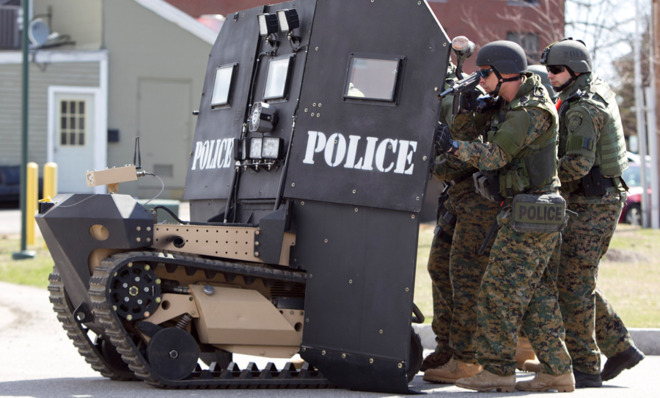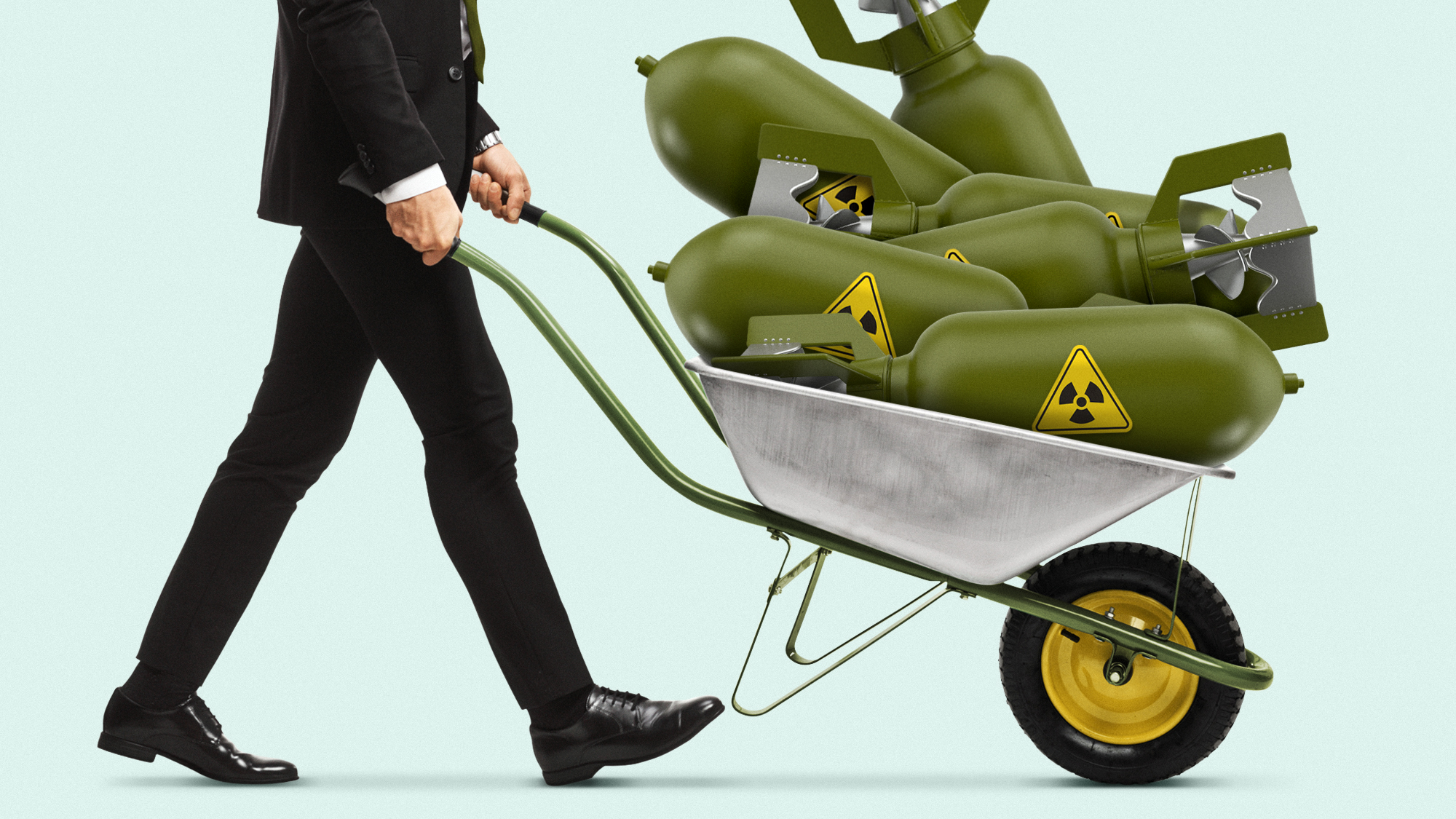The militarization of America’s police
Armed with battering rams and machine guns, paramilitary SWAT units are breaking into Americans' homes

How heavily armed are the police?
Many small-town police departments now boast the same weaponry once wielded by U.S. military units in Afghanistan — including tanks with 360-degree rotating turrets, battering rams, and automatic weapons. Those weapons are today deployed against Americans suspected of crimes in their own homes. Every day, Special Weapons and Tactics (SWAT) teams connected to local police conduct 124 paramilitary-style raids in the U.S., according to a new report by the American Civil Liberties Union. One of them recently drew national attention when a SWAT team in Atlanta burst into a private home and threw a live flash grenade into a 2-year-old's crib, severely injuring the toddler. Most raids by SWAT teams are conducted against suspected drug dealers, but they've also been deployed against a private poker game; a gay bar in Atlanta; a New Haven, Connecticut, bar suspected of serving minors; and even people suspected of credit card fraud. "Neighborhoods are not war zones," says the ACLU in its report, "and our police officers should not be treating us like wartime enemies."
Why do police have SWAT teams?
The Week
Escape your echo chamber. Get the facts behind the news, plus analysis from multiple perspectives.

Sign up for The Week's Free Newsletters
From our morning news briefing to a weekly Good News Newsletter, get the best of The Week delivered directly to your inbox.
From our morning news briefing to a weekly Good News Newsletter, get the best of The Week delivered directly to your inbox.
The first SWAT team was created by the Los Angeles Police Department in 1967 and reserved for the most extreme circumstances: riots, hostage scenarios, and active-shooter or sniper situations. But the "war on drugs," coupled with the sense of danger promoted by tragedies like the Columbine massacre in 1999 and the 9/11 terror attacks, encouraged police departments even in small towns and rural areas to create special units equipped and trained for worst-case scenarios. "There's violence in schools, and there's violence in the streets," said Sheriff Michael Gayer of Pulaski County in Indiana. "If driving a military vehicle is going to protect officers, that's what I'm going to do."
How do police get military equipment?
In recent years, the Department of Homeland Security has provided $35 billion to local police throughout the country to help buy weapons for "the war on terror." The rest can be traced to the Pentagon, which has off-loaded $4.2 billion of surplus armored vehicles, rifles, and equipment to police departments as the wars in Iraq and Afghanistan have wound down. Cash-strapped police departments obtain these weapons for free; all they have to do is pay for the shipping. SWAT teams have obtained tens of thousands of machine guns, night-vision goggles, silencers, armed helicopters, and armored vehicles. The Utah Highway Patrol, for example, owns a 55,000-pound, mine-resistant ambush-protected vehicle, or MRAP, complete with a gunner's turret. "I can drive this thing right through the middle of a gunfight," said Highway Patrol Lt. Alex Lepley.
Are SWAT tactics an overreaction?
A free daily email with the biggest news stories of the day – and the best features from TheWeek.com
In many cases, yes. Of the 124 SWAT raids conducted daily, only 7 percent meet the original LAPD criteria. About 62 percent of the raids are mounted to conduct drug searches — many of them based on tips from unreliable informants. Most are undertaken to investigate nonviolent offenses. In Orlando in 2010, for example, heavily armed SWAT teams raided nine barbershops and arrested 34 people for "barbering without a license." Adrenalin-fueled SWAT teams have often been accused of overexuberance: In 2011, an Arizona paramilitary police unit riding in military vehicles — including a tank driven by special deputy and action movie star Steven Seagal — drove straight into the living room of an unarmed man suspected of staging cockfights. Such "no-knock" operations are now commonplace — often with tragic consequences.
Why conduct no-knock raids?
The premise is that police need to catch suspects unawares and prevent them from resisting or destroying evidence of their alleged crimes — say, by flushing drugs down the toilet. So SWAT units routinely barge into houses unannounced, scream obscenity-laced commands to get down on the floor, and chuck flash grenades to disorient and subdue the occupants. In the general chaos and confusion, dozens of civilians have been killed. They include 7-year-old Aiyana Stanley-Jones, shot dead by police after one of their flash grenades set fire to her blanket. Other startled victims, assuming that their house is being invaded by armed intruders, are shot as they grab a gun to protect themselves. "Innocent people are hurting,'' said criminal defense lawyer Mawuli Davis.
What reforms have been proposed?
Changes could be made to the training of SWAT units, which the ACLU says teaches police to "adopt a 'warrior' mentality" toward any citizen suspected of crimes. Other advocates have called for states to pass legislation forcing police to provide reports on every SWAT raid they conduct. But it might take a high-profile tragedy for such laws to be passed. Maryland is one of only two states with a law requiring its police to track their raids. "That transparency bill only came [in 2009] after the high-profile botched raid on the mayor of Berwyn Heights," during which his two dogs were shot dead, said Radley Balko, author of Rise of the Warrior Cop. "It was vigorously opposed by every police group in the state."
Blowing the dog away
Perhaps the most common victim of police militarization is the family dog. About 250 to 300 cop-shoots-dog cases are now recorded in the U.S. media every year, according to Randall Lockwood of the American Society for the Prevention of Cruelty to Animals, and he estimates that another 1,000 aren't reported. Some of the shot dogs are dangerous breeds trained to attack, but many are family pets that simply get excited and fearful during raids and bark at police officers. The dead dogs include such breeds as Chihuahuas and golden retrievers, and even a miniature dachshund that made the mistake of growling at a police officer during one SWAT operation. "These guys think that the only solution to a dog that's yapping or charging is shooting and killing it," says former Seattle Police Chief Norm Stamper. "It goes with the notion that police officers have to control every situation."
Frances Weaver is a senior editor at The Week magazine. Originally from the U.K., she has written for the Daily Telegraph, The Spectator and Standpoint magazine.
-
 Trekking with gorillas in the warm heart of Africa
Trekking with gorillas in the warm heart of AfricaThe Week Recommends Great apes and an unforgettable encounter with elephants in the forests and swamps of the Congo
-
 New START: the final US-Russia nuclear treaty about to expire
New START: the final US-Russia nuclear treaty about to expireThe Explainer The last agreement between Washington and Moscow expires within weeks
-
 What do the people of Greenland want for their future?
What do the people of Greenland want for their future?As Europe prevaricates over US threats for annexation there is a unifying feeling of self-determination among Greenlanders